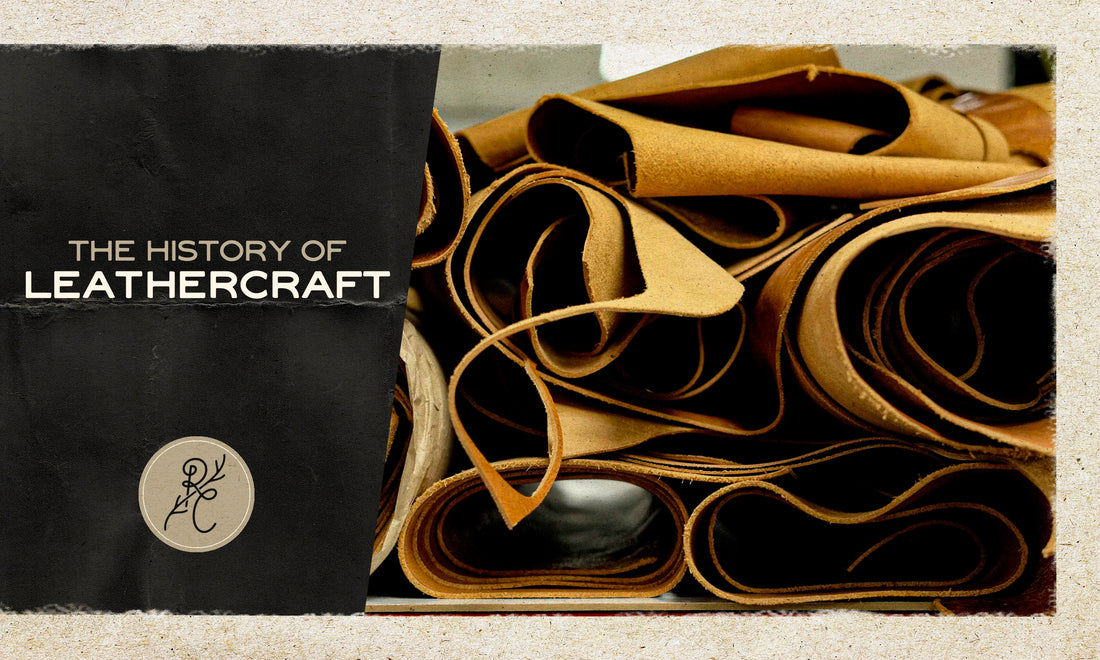
The History of Leathercraft
Share
How Leather Working Tools and Methods Developed over 3 Defining Ages.
Leathercraft was one of the first trades that arose in ancient times. Even though family units first made their own leather shelter and shoes, and later clothing, the first specialized tools for working with leather date back 5,000 years ago. It stands to reason that specially shaped stone leather working tools indicates that leathercraft was considered a specialized trade by at least that time.
According to many anthropologists, the making of clothing and shoes was one of the first trades that existed, which begs the question, when did leather working become a specialized trade? We can only guess, but there is no doubt that leathercraft has advanced over the ages. In particular, the Iron Age, the Middle Ages, and the Industrial Revolution saw significant advancements and new techniques that are still in use today.

Pre-history through the Bronze Age
Leather, while used extensively in shelter, clothing, and footwear, didn’t advance quickly during the dawn of history. The first evidence of scraping hides with stone tools for tanning date back to 400,000 years ago, when awls were used to pierce leather so that it could be joined and shaped with cords or laces. The first bone awls date back to 84,000 years ago.
About 25,000 years later, bone awls appear with eyes for sewing. While crude compared to today’s sewing needles, they would have been stiff enough and large enough to easily pierce through layers of tough leather.
Finally, during the Stone Age, having specially shaped stone tools to shape and work leather allowed for better fitting and more effective footwear and clothing, as evidenced by the oldest shoe found to date from about 3,500 years ago.
The Bronze age saw little change in the way that people worked with leather.

The Iron Age sees the dawn of leather fashion
With the ability for blacksmiths to make more precisely shaped tools, leatherworkers in the Iron Age were able to have specialized tools to work with leather in their own way. These tools were much more effective, and leather working around this time became much less crude.
With more options for tools and techniques come more opportunities for leathercraft to become an established trade. It is about half way through the Iron Age that we start to see the first signs of leather accessories for fashion and social status. The end goal of leather working is no longer just functionality – it becomes an artistic tradition.

The Middle Ages and Renaissance
We often thing of the Middle Ages and the Renaissance as two separate eras in history, but in reality, they overlap quite a bit. The Middle Ages are generally referred to as 500 – 1550 CE, when Queen Elizabeth I started the Golden Age of England.
The Renaissance refers to the period between 1400-1600 CE, but the movement was centralized to Italy and the surrounding Mediterranean. Still, vast trade practices meant that all of these leatherworking techniques produced goods that popped up all over the western world.
Here are some of the most significant techniques that came out of this period in history:
- Turnout methods of sewing were picked up by leathercrafters, allowing them to create footwear and outerwear that was more stylish and better kept out wind and rain.
- Joining different types of leather, such as using rawhide for the sole of a soft leather shoe, becomes common during this time.
- In England and Europe, tooling, painting, dying, and carving for decoration is seen on almost all leather goods, even those purchased for a utilitarian purpose.
- Meanwhile in Italy, shaping, stamping, and moulding leather becomes an artform.
Although leather items were still very functional, and many people did not have more leather goods than they truly needed, they all had some type of design or decoration. When we consider the opulent lifestyle of the times, it is no wonder that everything leather was as much about fashion as use.

The Industrial Revolution changes the leather industry forever
With the Industrial Revolution leather goods became even more popular and common place. Leather tanning and leathercraft had to evolve to make use of the new machinery. Like other trades, this was done rather successfully. After chromium tanning was invented in 1858, leather goods were no longer considered luxury items.
In addition to industrializing the processes used in leathercraft up to that point, the industrial revolution allowed for new methods of decoration and design to surface. These decorative techniques could be implemented in the factory setting while allowing for more precise and beautiful decorative pieces.
The most significant of these are:
- Patent leather, a coated leather with a high gloss, was invented in 1818 and is still in use today in dress shoes and luxury accessories. It was patent leather that made shoe shiners a necessity.
- Introduction of etching, and later laser carving, allowed for almost any pattern or design to be etched onto leather goods. This also allows for customization.
- The leather perforation technique, in which many holes are punched into the leather to create a unique design, was developed in 1857, and is also still used widely today.
- In the early 1900s, pyrography was developed in which a hot needle is used to burn designs into the leather. The most commonly known application of pyrography is woodburning, a favorite of summer camps everywhere.
Although there haven’t been many new advancements in leathercraft in the last 120 years, leather working isn’t standing still. Laser equipment and tools has of course advanced, and you can now buy leather items with just about anything emblazoned on them.
At the same time, many accessory and handbag designers are going back to the traditional leather working techniques that dominated the industry before mass production. Without a doubt, the most interesting leather fashions will continue to use a combination of both.
